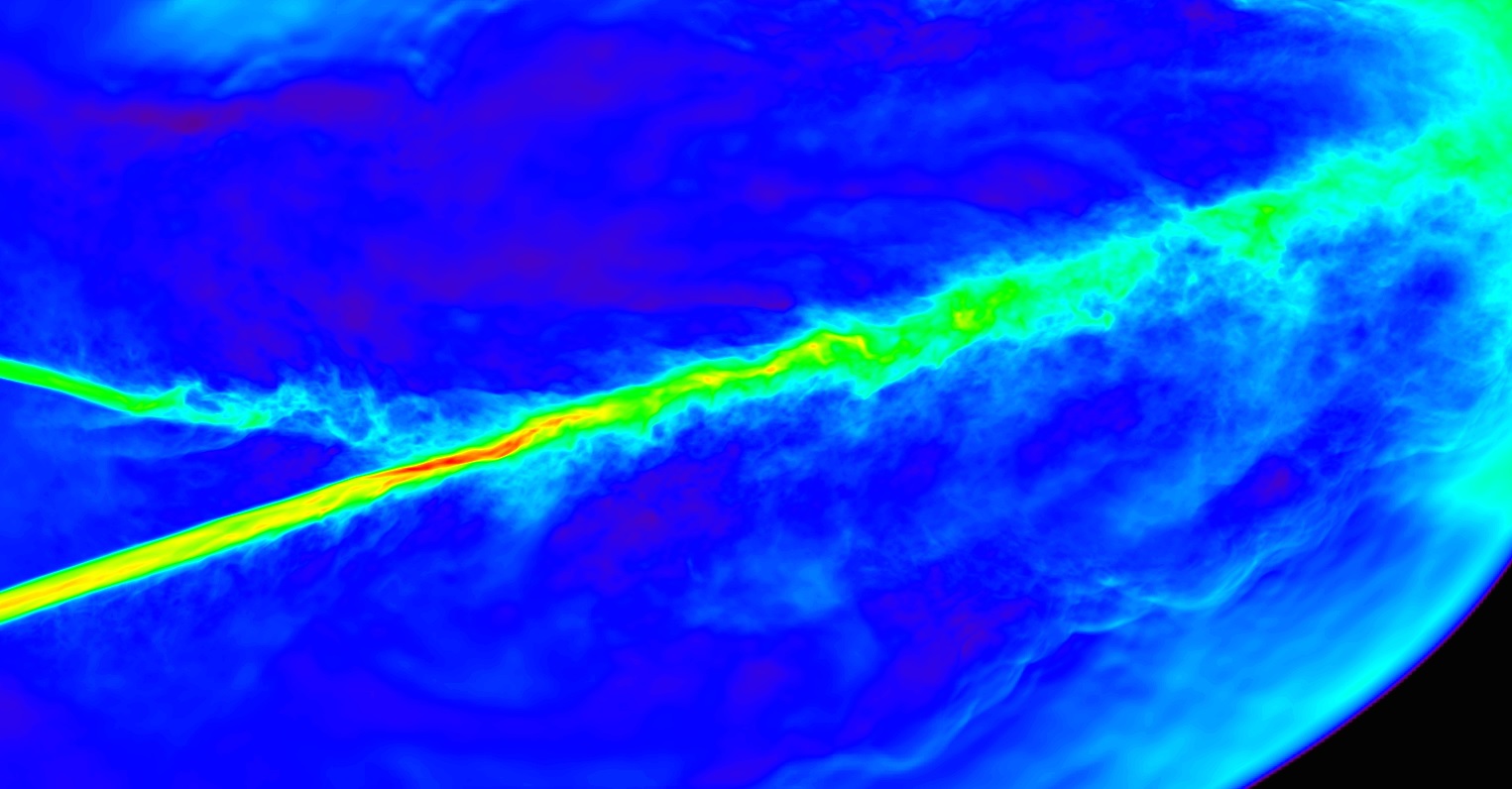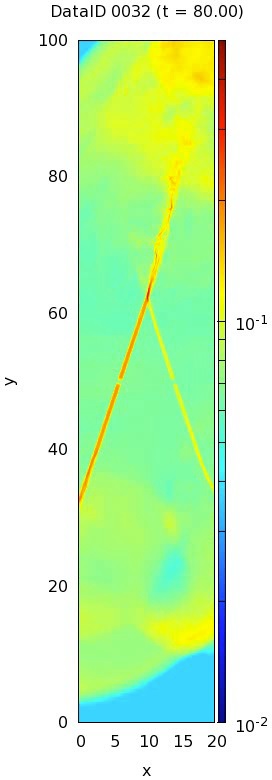
- Consulting
- HaaS
Our high performance computer architecture consists of CPUs and GPUs.
The performance of a CPU/GPU architecture is optimized by using CPUs
for the decision making, communications, data streaming and distribution
of the computational load to the GPUs, and using GPUs for the actual
numerical hydrodynamical calculations.
We demonstrate the capabilities of our system by running a colliding jet simulation using a GPU-accelerated Adaptive-MEsh-Refinement hydrodynamical parallel code (GAMER) developed at the National Taiwan University.
In Figure 1 We show the total energy (kinetic plus thermal) projected to the main plane of the jet. The jets are injected on the left hand side and moving to the right. The jet Mach number, Mj, of the slower jet was 4.4 (green color, upper left hand side traveling downward). The faster jet with Mj = 7.9, and therefore higher total energy, is marked with green-orange color (lower jet traveling upward). This is not a head-on collision, the jets are offset by about half of their diameter.

Figure 1 Total energy projected to the main plane of the jet. The jets are moving from left to right.
In Movie 1 we show the total energy (kinetic plus thermal) projected to the main plane of the jet. The box size, in simulation units, were 20x100x20.

Movie 1> Total energy (kinetic plus thermal) projected to the main plane of the jet.
We demonstrate the capabilities of our system by running a colliding jet simulation using a GPU-accelerated Adaptive-MEsh-Refinement hydrodynamical parallel code (GAMER) developed at the National Taiwan University.
In Figure 1 We show the total energy (kinetic plus thermal) projected to the main plane of the jet. The jets are injected on the left hand side and moving to the right. The jet Mach number, Mj, of the slower jet was 4.4 (green color, upper left hand side traveling downward). The faster jet with Mj = 7.9, and therefore higher total energy, is marked with green-orange color (lower jet traveling upward). This is not a head-on collision, the jets are offset by about half of their diameter.

Figure 1 Total energy projected to the main plane of the jet. The jets are moving from left to right.
In Movie 1 we show the total energy (kinetic plus thermal) projected to the main plane of the jet. The box size, in simulation units, were 20x100x20.

Movie 1> Total energy (kinetic plus thermal) projected to the main plane of the jet.







 WinSet offers data mining services and consulting. We have unique capabilities
for modeling group behavior, both in markets and politics. Modeling the behavior
of a group of decision makers presents unique challenges, especially when the
group faces multiple issues. The unique modeling tools developed by WinSet are
applying Nobel prize winning theories to forecast group decision making and
behavior. Examples of such decision contexts abound, from markets, legislatures,
juries, and boards of directors, to stockholders, associations, and families.
WinSet offers data mining services and consulting. We have unique capabilities
for modeling group behavior, both in markets and politics. Modeling the behavior
of a group of decision makers presents unique challenges, especially when the
group faces multiple issues. The unique modeling tools developed by WinSet are
applying Nobel prize winning theories to forecast group decision making and
behavior. Examples of such decision contexts abound, from markets, legislatures,
juries, and boards of directors, to stockholders, associations, and families. We offer our tools for sale. We encourage our customers to also receive
training in the use of WinSet's tools and associated methodology to
ensure our customer's success using our products.
We offer our tools for sale. We encourage our customers to also receive
training in the use of WinSet's tools and associated methodology to
ensure our customer's success using our products. If you want to learn more about what we do, WinSet offers training in
decision analysis covering data mining, and group decision behavior. Our
training is directed toward practical application of state-of-the-art
principles and technologies for decision analysis.
If you want to learn more about what we do, WinSet offers training in
decision analysis covering data mining, and group decision behavior. Our
training is directed toward practical application of state-of-the-art
principles and technologies for decision analysis.